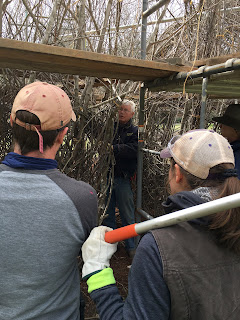 |
| Scaffolding helps to keep the foundational elements in place during creation. Photo by Bill LeFevre. |
A bird’s nest. A treehouse. An alien spaceship. A new sculpture, constructed entirely out of locally harvested saplings, is taking shape on the South Lawn of Duke Gardens. Starting this week and for the next two weeks, Triangle sculptor Patrick Dougherty will construct his latest creation with the help of a rotating crew of Gardens staff and volunteers. Even in its unfinished state, the sculpture is already drawing a great deal of talk and opinions. And that’s just how Dougherty likes it.
 |
| Dougherty and a volunteer add more sticks to the mix. Photo by Orla Swift. |
Beloved for picnicking and sunbathing, strolling and (ostensibly) studying, the South Lawn now takes a turn as host to a public art installation. Already this sculpture has undergone several transformations. On Friday morning, the third day on site, a small forest of red maple and sweetgum saplings harvested in Duke Forest earlier in the week had sprung up on the center of the lawn, complete with a luxurious carpet of mulch and surrounded by a halo of temporary scaffolding. More saplings, piled in thick bundles, lay nearby. By lunchtime, Dougherty had begun to pull the tops of the branches into graceful, looping curves and lash them into place, while three volunteers gracefully wove smaller branches in between the trunks at their base.
 |
| Weaving sturdy walls. Photo by Orla Swift. |
Duke Gardens executive director Bill LeFevre approached Dougherty several years ago with a proposal to bring his artistry to the Gardens. As the project date drew closer, they agreed upon an ideal location. When the work began, LeFevre and Gardens staff members enthusiastically signed up for opportunities to play a hands-on role.
“We are thrilled and thankful to have the opportunity to work with Patrick Dougherty and his team to create this site-specific work of art in Duke Gardens,” said LeFevre, whose shifts with Dougherty left him somewhat scratched up but also energized and inspired.
“We collected thousands of saplings from Duke Forest, and now we all get to play a role in bending them into Patrick’s emerging vision for the piece,” he said. “I hope visitors will enjoy witnessing this process of creation.”
 |
| Dougherty explains his techniques to staff members who will assist. Photo by Orla Swift. |
So, what is it exactly taking shape on the South Lawn? It’s a castle. It’s a forest. It’s a home for elves. It’s a photo opportunity. It’s a chance to get in touch with nature again or an inspiration to build a tree fort of your own at home. Or perhaps it’s none of those things at all for you. But one thing is for certain: whether you’re involved with the construction or just passing through, Dougherty’s work is likely to intrigue and engage you.
Katherine Hale is an intern in the Blomquist Garden of Native Plants at Duke Gardens and a graduate student in the Field Naturalist program at the University of Vermont.
Read more about Patrick Dougherty and his work in the latest issue of Garden & Gun magazine.
Update: Below is the finished sculpture, in a photo by Rick Fisher. You can read more about it in our 2017 Flora Magazine.

join us when we celebrate the completion of Patrick's sculpture on the South Lawn at 3 pm on Friday, February 24th...
ReplyDeleteLovely!
ReplyDeleteHow long does Duke plan to keep the piece?
ReplyDeleteWe anticipate that it will be here about two years. Come see!
Delete